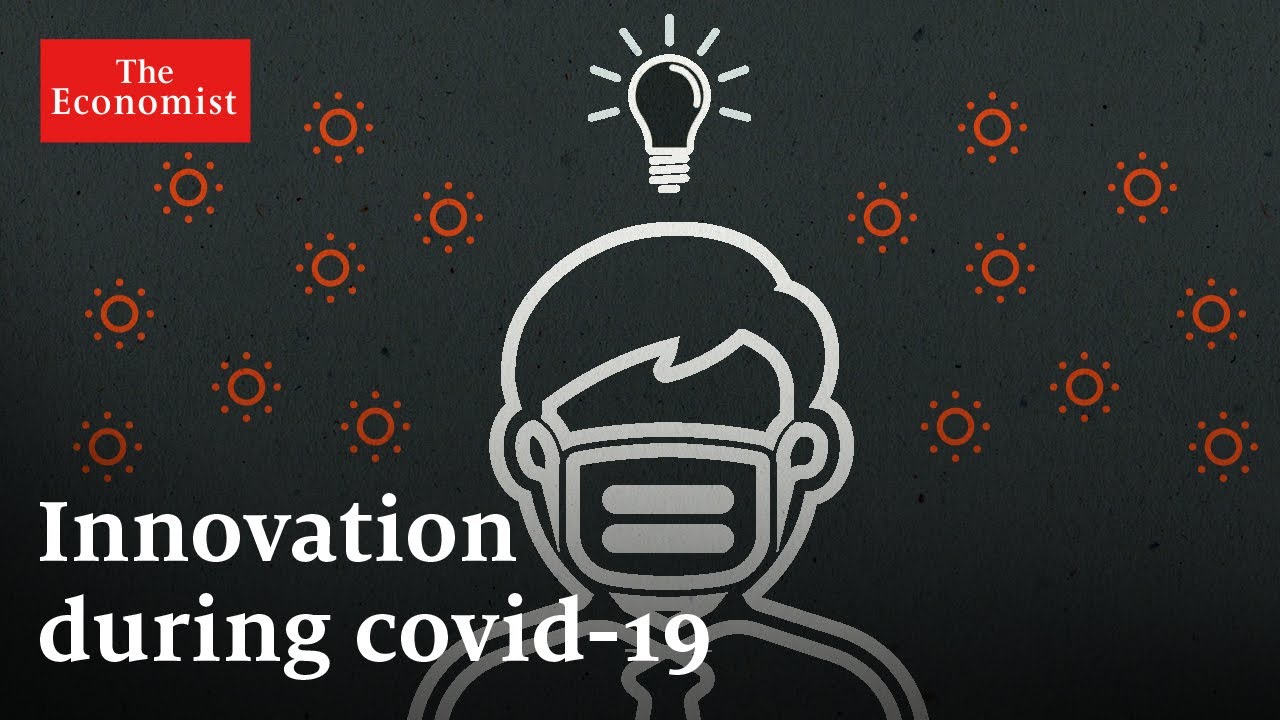In Cloud Consulting
How covid-19 is boosting innovation | The Economist - read the full article about cloud technology 2021, Cloud Consulting and Data migration, Cloud infrastructure management from The Economist on Qualified.One

Youtube Blogger

There’s a less familiar story about covid-19 The crisis is boosting innovation...
...with the emergence of brand new ideas...
mRNA vaccine, a new technology ...and with the application of existing ones...
...in surprising new ways The crisis has caused an acceleration in adoption of technologies This is pushing the world further into the future...
We’ve had to build more aeroplanes than we ever have before ...often at breakneck speed We’ve just closed £250m Businesses are being forced to adapt...
Hello Thank you, amazing ...or face extinction Another hammer-blow to Britain’s retail sector This upsurge in innovation will bring lasting change… …for good… …and bad Could you get into your computer? No This is my kids’ future So what lessons can be learned… …as the world looks towards the post-pandemic era? There is an opportunity for innovation… …to stay at the cutting edge I haven’t seen this Is this a new piece? What is this part? It’s the front of the fuse Got it This is the headquarters of Zipline… …a drone-manufacturing company Is this 3D printed? Yeah Oh this is plastic now, yeah Yeah, totally Since the pandemic… …the business has really taken off Drone technology has been around for a while… …but during the pandemic… …it’s starting to realise its considerable potential With social distancing the new normal… …health systems around the world… …are now looking at drones… …as a new and better way to deliver products… …such as blood, cancer treatments and vaccines Every hospital system and health system on Earth… …is suddenly trying to reconfigure itself to a new reality… …to extend the reach of the hospital system… …directly into the home… …enabling care closer to where patients live… …so they have to travel less It’s more convenient… …and the patient takes less risk of getting infected… …if they need to access general care From mid-June to September 2020… …Zipline delivered more than 100,000 medical products… …as many as over the previous three years We’ve done a few things...
...a set of wing covers there now When did that change? Weeks ago Perhaps the most significant change… ...has come in countries with strict airspace laws In May 2020, an emergency licence was issued in America… …allowing Zipline to fly long-range delivery drones… …through controlled airspace for the first time And in December, American regulators issued new rules… …allowing drones to fly over people, and at night This looser approach is accelerating the shift… …towards more states receiving medical supplies… …in a more efficient and productive way So we’re seeing hospital systems… …that previously thought they had ten years… …to effect this kind of change… ...now trying to do this in one year Although drone-filled skies are some way off… …covid-19 has also accelerated the conversation… …around the use of drones beyond health care… …in a variety of new fields So I’ll pop this… …I’ll pop this out Zipline has partnered with retail giant Walmart It’s one of a number of companies… …due to begin trial deliveries of consumer products I think it’s been really easy for people to understand the value… …and there’s a pretty intense sense of civic pride… …around the country leading the way… …in terms of showing how this new technology can save lives This kind of rapid adoption of emerging technologies...
...has been called “tech-celeration”...
...and it’s the type of innovation...
...that has been given the biggest boost...
...around the world by the pandemic A classic example of tech-celeration… …was what happened in the National Health Service in England… …where a system to make possible video-calling… …was effectively built over a weekend… …and then rolled out to doctors across the country Tech-celeration is pushing companies further and faster… …into the future Exactly how many years into the future we’ve been pushed… …by this crisis varies It depends on the behaviour, it depends on the country… …but it does seem to be, sort of, of the order of five years So welcome to 2025 History shows that innovation often thrives during times of crisis Take the financial crash of 2008… …which led to the widespread adoption of cloud computing The cloud had been around since the early 2000s… …but it gained a new footing… …as the economic slowdown took hold Companies were very often reluctant to try cloud computing They thought it wasn’t secure And then they gave it a try… …found it was cheaper, found it was more secure And cloud computing has expanded very rapidly As well as accelerating the adoption of developing technologies… …crises can also foster the development of entirely new ideas A good example of a crisis that led to lots of invention… …would be the second world war So you get the first digital computers… …which are used for code-breaking… …you get the first jet engines… …that paves the way for mass air travel… …you get nuclear technology, which is used for weapons… …but can also be used to generate energy And you also get the first rockets When it comes to new ideas… …covid-19 has left its mark in the field of medicine… …where researchers around the world… …have pioneered new techniques… …in the development of vaccines This phenomenal work has been done Multiple teams producing vaccines in months rather than years… …using entirely new technologies in some cases So these mRNA vaccines are a new type of vaccine… …and they seem to work extremely well So that’s very impressive example of invention We are collectively telling cafés, pubs, bars and restaurants to close In most industries, the pandemic has boosted innovation… …by forcing companies to adopt new ways of doing things… …purely as a matter of survival We have innovated for necessity Even for Michelin-star restaurant owner, David Moore Lockdown forced him to place 90% of his staff on furlough… …an emergency government scheme… …that pays the wages of workers For the business, it meant we had no income I had thought that maybe… …we wouldn’t be able to get back to doing what we did before So, to save his business...
...David adopted something once unthinkable...
...in the rarefied world of fine dining...
...a takeaway The restaurant turned this...
...into this...
Thank you, amazing ...a heat-at-home Michelin-star ready-meal Now the restaurant’s Vegan Box has proven so popular… …it has been rolled out nationwide I definitely see online… …as something that’s staying with us It’s totally invigorated the business Billy that’s the samphire As businesses throughout the hospitality industry… …have been forced to adapt… …the pandemic has fuelled the rapid growth… …of the meal-delivery industry Globally, the total revenue of this industry… …is now expected to reach $182bn by 2024… …an increase of more than a third from the projected level in 2020 When the pandemic recedes...
...the innovative mindset many businesses...
...have been forced to embrace, looks set to linger For David, the unexpected success of his food-delivery service… …points to a hybrid model for the future… …one that will allow his chefs… …to continue to innovate in the kitchen Home delivery is not gonna finish fine dining Fine dining is here to stay People want to be looked after… …they want crisp linen… …they want the waiters looking after them… …and they want no washing up afterwards But while the pandemic has made innovation… …a necessity for some companies… …it has also restricted opportunities for others Amidst the huge economic downturn… …companies have been consolidating The third quarter of 2020… …was the busiest for mergers and acquisitions in three decades… …a trend that is likely to tilt resources… …for new thinking and new ideas… …further towards big companies By and large big companies can continue to invest...
...in difficult times They can continue to take market share...
...in a way that small companies can’t...
...and so generally this is leading...
...to sort of greater inequality between companies It’s a sort of big-gets-bigger phenomenon There are parts of America you can only scout...
...if you come in here Your international Harvester dealer showroom History also suggests...
...that successful companies tend to start life...
...more often in the good times than the bad Of the biggest American firms founded since 1970...
...more than 80% were born during eras of growth During economic downturns life can be much harder for startups...
...which are so often the engines of innovation But back in the booming world of online food delivery...
...some startups have found hungry investors So we just closed £250m We just closed £250m Sisters Gini and Eccie Newton run Karma Kitchen It’s a startup that offers flexible kitchen space...
...known as ghost kitchens...
...to cooks and restaurants catering mainly to the delivery market While some ghost kitchens are owned by a single-restaurant chain...
...Karma Kitchen has many different companies...
...hot-stationing under one roof Producing everything from west African donuts...
...to tandoori curries The company was founded two years ago...
...and the pandemic has transformed its fortunes What would have taken us potentially three years to achieve...
...has now taken eight months in terms of market demand The startup has recently opened its second ghost kitchen in London...
...and it has another five sites under construction It plans to build many more ghost kitchens in residential...
...and office hotspots across Europe We want to open 60 kitchen facilities That starts for us with the funding The ambition of fast-growing startups like Karma Kitchen...
...can attract investors But it can also end with the startup selling itself...
...to a larger company with deeper pockets And that brings its own risks You see from research on mergers and acquisitions...
...when an acquisition happens...
...the innovativeness of that small firm typically goes down The question really is whether large conglomerates...
...will be able to fuel these startups...
...in order for them to carry the front in terms of innovation...
...and for that innovation to then be...
...disseminated into the rest of the organisation For many large and small companies...
...working from home has been the most significant innovation...
...to come out of the pandemic In 2020 covid-19 turned a little-known tech firm...
...into one of the success stories of the pandemic At the start of the year...
...about 10m people were taking part in meetings over Zoom each day But this had shot up to 300m...
...by April 2020 And the widespread adoption of remote working during the pandemic...
...could lead to further innovation in future More companies may be inclined to take risks...
...and embrace new ideas in the coming years They’ve discovered that actually working from home...
...can work really well and doesn’t seem to make people less productive It may make people more productive That will mean that after the crisis, companies will be more willing...
...to keep some of those behaviours Maybe have less business travel, maybe have more working from home...
...and maybe even dare to try other things that they were reluctant to So, it’s just allowing them to be tested...
...and not punishing people if they don’t work...
...because that’s just going to put them off Some of the most groundbreaking ideas...
...require the right opportunity and circumstances...
...to demonstrate their value Two decades ago...
...e-learning emerged as a radical new idea...
...predicted to transform the world of education But such predictions fell flat...
Sending all students home for the rest of this semester...
...after a coronavirus outbreak on campus ...until covid-19 struck...
...and the potential of remote learning became clear The online-education market...
...is set to nearly quadruple between 2019...
...and 2026 The pandemic has really changed the culture...
...inside educational institutions...
...and made them more open to adopting e-learning Online learning democratises learning to a great extent...
...it has allowed students to really customise learning...
..to their needs and you could complete an entire degree online...
...because you may be in a part of the world...
...where it’s very difficult for you to commute to a university The culture change around online learning seems here to stay...
...but with it comes a reminder that new innovations...
...can also struggle to overcome some old challenges For full-time university student and mum of three...
...Christina Holley, studying before the pandemic was going well Every semester I got As and Bs I was meeting and beating my own expectations And my kids were studying really hard...
...and grades were good But now Christina is unable to afford the technology...
...required to allow her family to participate in the switch to e-learning Having the transition to online education...
...was terrible, there weren’t enough devices in the home I want to try and restart the internet first Using one Chromebook for three children...
...is terrible First of all their schedules were at the same time So when all three of you have to start school...
...at 8.30, on one Chromebook...
...it’s impossible According to America’s education department...
...nearly one-in-eight children do not have internet access...
...via a desktop or laptop at home Digital learning looks likely to entrench social inequality...
...in the post-pandemic world The reliance on technology has really surfaced these...
...inequalities that existed before...
...but that were not as present because everyone was in a room together Christina says that falling behind...
...could force her to become a part-time student...
...and that this will reduce her financial aid...
...and affect her ability to pay for her college studies I hate to even think about what that means...
...because this is my life...
...you know, this is my kids’ future There is really no other option for me other than school This is what I need to do in order to bring us out of poverty Many of the innovations that have flourished during the crisis...
...are centred around digital technology...
...and will have become part of everyday life...
...when the world returns to more ordinary times Technologists and policymakers...
...face the challenge of ensuring these new innovations...
...do not entrench inequality, but instead broaden opportunity I think that this is really...
...an important chance for humanity...
...to not only bring new technology to bear...
...but for the first time bring it to bear in a way that is...
...equitable for humans on Earth Hello I’m Tom Standage, deputy editor at The Economist If you’d like to read more about how covid-19 is...
...driving innovation then click on the link opposite And if you’d like to watch more of our Now & Next series...
...then click on the other link Thanks for watching and please don’t forget to subscribe
The Economist: How covid-19 is boosting innovation | The Economist - Cloud Consulting

